

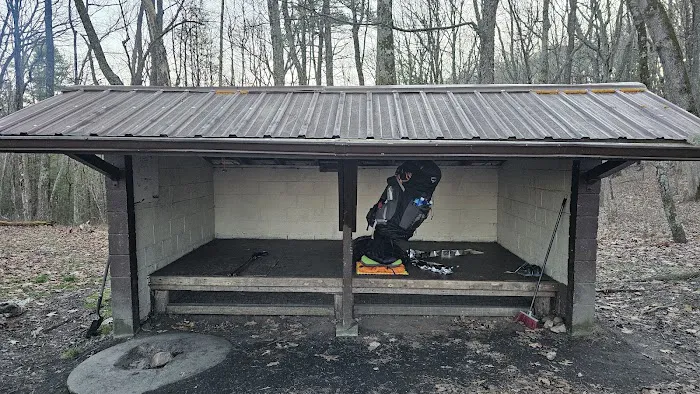
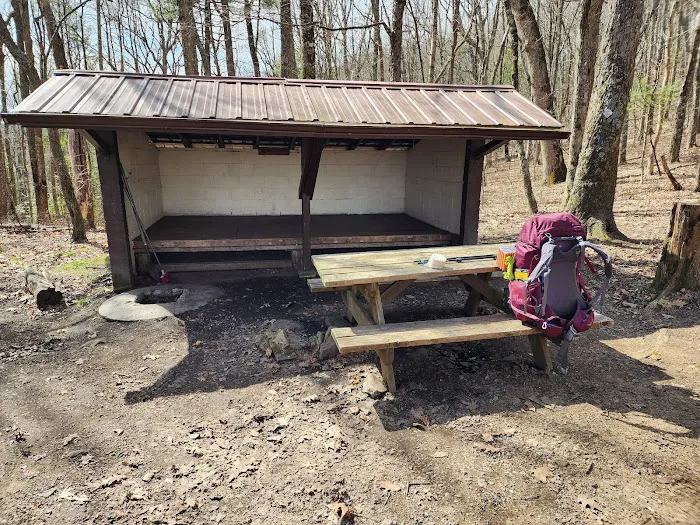
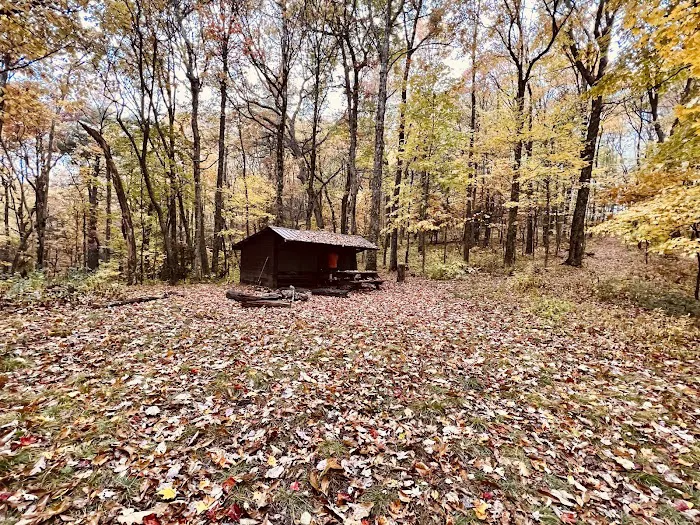


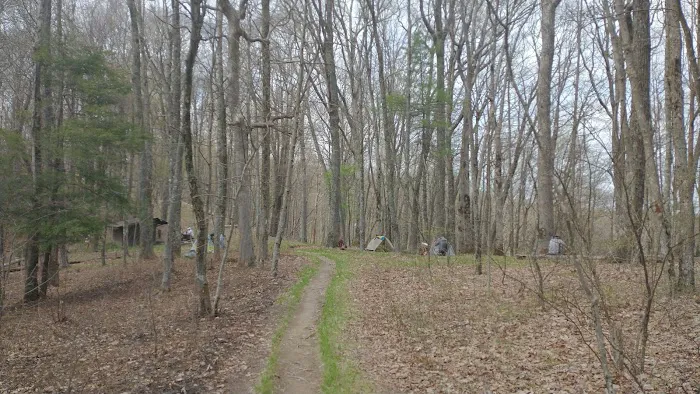
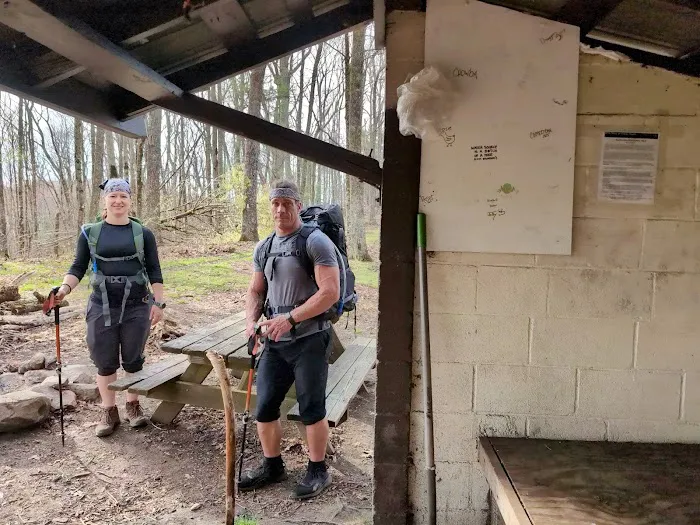
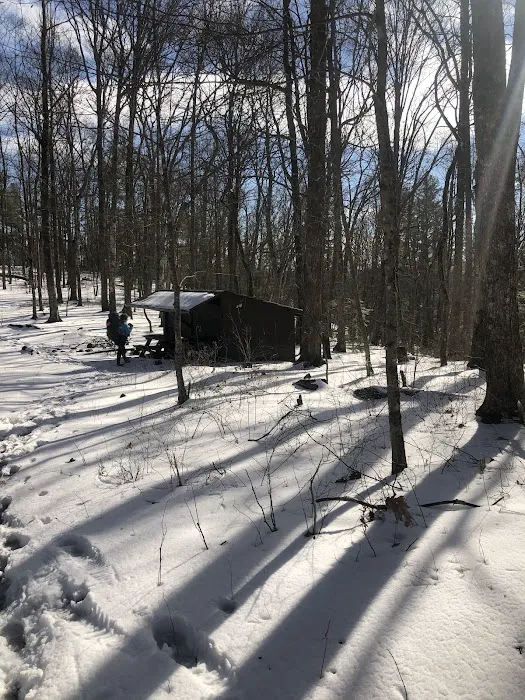
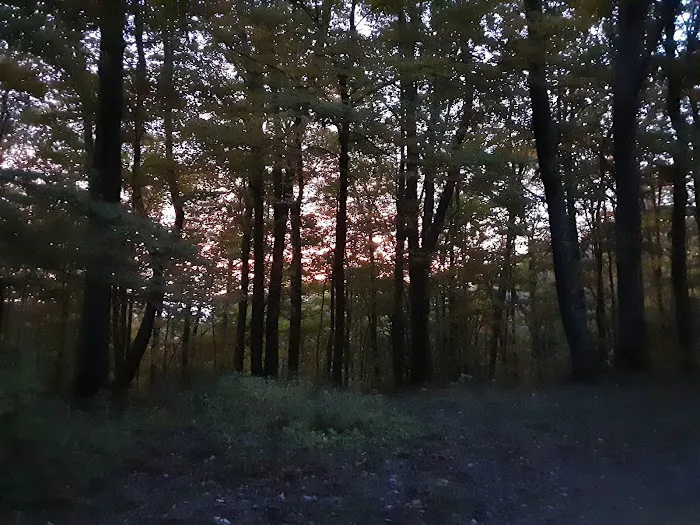
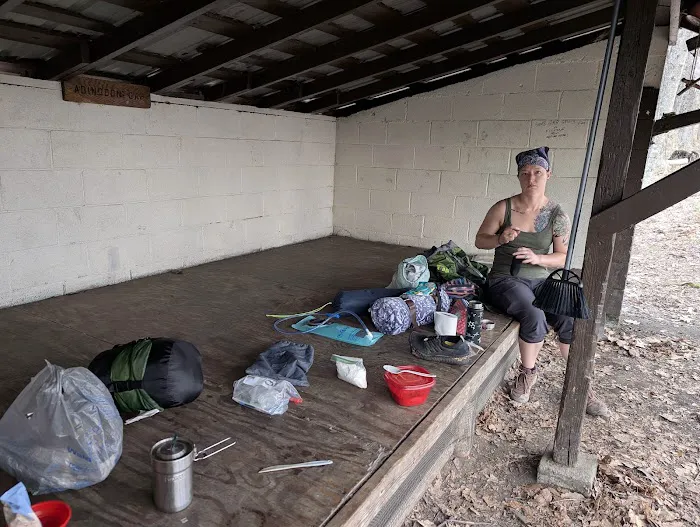
Appalachian National Scenic Trail, Shady Valley, TN 37688, USA
For Tennessee locals who cherish the challenge and camaraderie of long-distance hiking, particularly along the legendary Appalachian National Scenic Trail (AT), understanding the critical points along the path is essential. Abingdon Gap Shelter, strategically located near Shady Valley, TN, is not a traditional drive-up campground with extensive amenities. Instead, it serves as a vital backcountry shelter, offering fundamental refuge and basic provisions for hikers tackling this iconic footpath through the mountains of Northeast Tennessee.
Abingdon Gap Shelter plays a crucial role in the Appalachian Trail experience for both northbound (NOBO) and southbound (SOBO) thru-hikers, as well as for section hikers exploring Tennessee's rugged beauty. Its position in relation to the popular trail town of Damascus, Virginia, makes it a significant waypoint, influencing hikers' planning for resupply and rest. Understanding Abingdon Gap Shelter means appreciating the unique demands of backcountry hiking and the minimalist infrastructure that supports thousands of adventurers each year.
Reviews from real customers provide invaluable insights into the shelter's offerings and its character: "If you're headed to Damascus, enjoy the nice downward slope. If you're coming from Damascus, stock up on water at the water point before getting here. The .1 hike down to water is steep and feels like much longer when you make the .1 climb back out. Water point feels very secluded, not a lot of light, and can host an army of bugs in the spring and summer. Ignore the 'Abandon all hope ye who enter here sign' as you go for water. Lots of options for tent and hammock setup if you can't or don't want to be in the shelter. Almost no low hanging branches for bear bags, but there are a few if you look carefully."
Another reviewer adds, "Great tenting spaces and a lot of them. Good bear bagging spots. Picnic table. Piped spring a long 0.2 down behind the shelter. A lot of bugs. Most active bear region of our section." Finally, a strategic note: "Going to be a popular populated spot for thru hikers prepping for Damascus. About 6 good tenting spots just north of here within 5 miles."
These direct accounts highlight the practicalities of Abingdon Gap Shelter: essential water access (though challenging), ample tenting options beyond the shelter itself, the critical need for bear-aware practices in an active bear region, and its popularity as a staging point for the near-approaching trail town. These details are invaluable for Tennessee hikers planning their journey through this demanding yet rewarding section of the AT.
This article aims to provide a clear, factual, and informative overview of Abingdon Gap Shelter from the perspective of Tennessee locals, particularly those who are active in the hiking community. It will detail its location, essential services, key features, and why such a fundamental amenity is so suitable for those traversing Tennessee's portion of the Appalachian Trail.
Tennessee's segment of the Appalachian Trail offers diverse terrain, from deep forests to stunning ridgelines. Reliable shelters like Abingdon Gap are not just places to sleep; they are critical components of hiker safety and well-being. The presence of bear bagging spots, even if limited for low-hanging branches, underscores the importance of wildlife precautions in this region, which is known for active bear populations. Hikers must always practice Leave No Trace principles, especially regarding food storage, to minimize human-wildlife conflicts.
Water sources are always a primary concern for backpackers. The detailed description of the "piped spring a long 0.2 down behind the shelter" and the "water point" which is a "steep .1 hike down" provides essential logistical information. While challenging, the availability of water, even if it requires effort, is a crucial amenity in the backcountry. Hikers are reminded that all natural water sources must be treated before consumption.
The popularity of Abingdon Gap Shelter as a "populated spot for thru hikers prepping for Damascus" speaks to its strategic value. Damascus, VA, is a beloved trail town, known for its hiker-friendly atmosphere and resupply opportunities. Abingdon Gap serves as one of the last major stops before reaching this significant waypoint, making it a place where hikers often converge, sharing stories and anticipation for the next phase of their journey. This communal aspect is a cherished part of the AT experience for many.
Abingdon Gap Shelter is uniquely located along the Appalachian National Scenic Trail, near Shady Valley, TN 37688, USA. This places it directly on one of the world's most famous long-distance hiking trails, within the mountainous and forested landscapes of Northeast Tennessee. For Tennessee locals, understanding its precise location and accessibility is crucial, as it is a backcountry facility reached exclusively by foot.
The shelter's primary accessibility is, by definition, through hiking the Appalachian Trail. Hikers will reach it after covering a certain number of miles along the AT, whether heading northbound (NOBO) towards Damascus, Virginia, or southbound (SOBO) further into Tennessee. While the address "Appalachian National Scenic Trail, Shady Valley, TN" provides a general geographical context, a hiker's specific approach would depend on their direction of travel and their previous stopping point on the trail.
Abingdon Gap Shelter is situated in a particularly strategic position relative to Damascus, VA, a renowned "trail town" located just north of the Tennessee-Virginia border. For northbound hikers, Abingdon Gap is one of the final shelters before reaching Damascus, making it a popular "prep" spot for resupply and a brief respite before the amenities of town. For southbound hikers, it's one of the first shelters encountered after leaving Damascus, signaling a return to more remote trail sections.
While the shelter itself is only accessible by foot, the general area around Shady Valley, TN, is accessible by vehicle. This allows for shuttle services, trail access points, and potential resupply options for hikers. Popular road access points that are relatively close would include those leading to the AT near Damascus, VA (just north), or further south along Highway 421 near Shady Valley. Hikers can arrange for shuttles to drop them at a trailhead and pick them up at another point, making a section hike that includes Abingdon Gap feasible.
The terrain in this section of the AT, typical of the Southern Appalachians, involves significant elevation changes, dense forest, and sometimes rocky paths. Hikers should be prepared for rugged conditions and the remote nature of the location. The reviews specifically mention the "steep" hike down to and back from the water source, highlighting the physical demands of accessing even basic amenities in the backcountry.
Abingdon Gap Shelter, as a quintessential backcountry shelter on the Appalachian Trail, offers a focused set of essential services designed to meet the fundamental needs of hikers. These are basic provisions, not commercial offerings, aimed at supporting self-sufficient trail users in a remote environment:
Overnight Shelter: The primary service is providing a rustic, three-sided lean-to structure for overnight lodging. It's built to offer protection from the elements (rain, wind, cold) and typically features a raised wooden platform for sleeping. Reviews imply it's a "medium-sized shelter" designed for communal sleeping, providing a designated, durable place to rest.
Tenting and Hammock Space: Critically, reviews emphasize "Lots of options for tent and hammock setup if you can't or don't want to be in the shelter." This indicates ample and suitable flat ground around the shelter area for pitching tents, and sufficient trees for hammocks, offering flexibility for hikers who prefer their own sleeping arrangements.
Water Source: Access to a natural water source is a vital service. Reviews detail a "piped spring a long 0.2 down behind the shelter" and another "water point" that is a "steep .1 hike down" from the shelter. Hikers are responsible for treating all natural water sources (filtering, purifying, or boiling) before consumption to ensure safety.
Bear Bagging Spots: While reviewers note "Almost no low hanging branches for bear bags, but there are a few if you look carefully," the availability of some spots for hanging food is an important service. This encourages safe food storage practices to protect both hikers' provisions and local wildlife in a "Most active bear region."
Picnic Table: A shared picnic table is present, as mentioned in reviews. This provides a convenient, relatively flat surface for meal preparation, eating, and socializing among hikers.
Privy (Outhouse): While not explicitly mentioned in the provided text, nearly all AT shelters are equipped with a primitive privy (outhouse) for human waste disposal. This is a standard and essential service for sanitation and environmental protection in high-use backcountry areas. Hikers should bring their own toilet paper and hand sanitizer.
Information/Log Book: Like most AT shelters, Abingdon Gap likely contains a log book where hikers can sign in, share messages, and glean information from previous visitors. This informal communication hub is invaluable for trail updates and fostering community.
It is crucial to remember that Abingdon Gap Shelter provides primitive services. There are no electrical hookups, running water indoors, showers, or trash collection. Hikers must be self-sufficient, practice Leave No Trace principles, and pack out all their trash.
Abingdon Gap Shelter, despite its rustic nature, boasts several significant features and highlights that make it a notable and often crucial stop for Tennessee locals and other hikers traversing the Appalachian Trail:
Strategic Proximity to Damascus, VA: This is a major highlight. For northbound (NOBO) thru-hikers, Abingdon Gap is one of the last major shelters before reaching the popular and hiker-friendly town of Damascus, Virginia. This makes it a key staging point, a place for hikers to prepare for resupply, rest, and enjoy the amenities of a trail town. For southbound (SOBO) hikers, it's one of the first shelters after leaving Damascus, signifying a return to more remote trail sections.
Ample Tenting and Hammock Space: Unlike some shelters that offer limited overflow, Abingdon Gap is praised for having "Great tenting spaces and a lot of them" and "Lots of options for tent and hammock setup." This flexibility is highly valued by hikers who prefer sleeping outside the shelter or when the shelter is full.
Reliable Water Source (with a Catch): The presence of a "piped spring a long 0.2 down behind the shelter" and another "water point" is critical. While the latter is noted as a "steep .1 hike down," the availability of water, even with effort, is a defining feature for backcountry travel.
Bear-Active Region: Abingdon Gap is located in an "active bear region," making it a notable spot for wildlife awareness. While this necessitates careful food storage (bear bagging), it also highlights the authentic wilderness experience available here. The mention of "good bear bagging spots" indicates that despite challenges, options exist.
Communal Picnic Table: The presence of a picnic table offers a shared space for hikers to cook, eat, and socialize, fostering the strong sense of camaraderie often found on the AT.
Challenging Terrain in the Vicinity: The "steep" climb back from the water source and the general elevation changes around the shelter are characteristic of this section of the AT, offering a genuine taste of the trail's physical demands and rewarding hikers with a sense of accomplishment.
"Abandon All Hope" Sign: While humorous and informal, the mention of the "Abandon all hope ye who enter here sign" near the water point adds a unique, memorable, and somewhat infamous character to the shelter, often shared among hikers.
Abingdon Gap Shelter, being a backcountry shelter on the Appalachian National Scenic Trail, is a public amenity provided and maintained by various trail clubs, the National Park Service, and volunteers. As such, it does not offer commercial "promotions or special offers" in the traditional sense of a business. Its primary "offer" is the provision of free, essential shelter and amenities to hikers.
However, for Tennessee locals and hikers, the inherent values and practical benefits of Abingdon Gap Shelter can be considered its ongoing "special offers":
Free Overnight Accommodation: The most significant "promotion" is that use of the shelter (and most AT shelters) is free of charge. This is invaluable for long-distance hikers, significantly reducing the cost of their journey and making extended trips more accessible.
Strategic Resupply Point Proximity: Its location as a popular "prep spot" for Damascus, VA, a well-known trail town with resupply options, effectively offers a "service" of convenience and strategic planning for hikers. This indirect benefit saves hikers time and logistical effort.
Extensive Tenting/Hammock Space: The availability of "Great tenting spaces and a lot of them" around the shelter is a significant advantage. This allows hikers flexibility and comfort, especially when the shelter itself is full, or they prefer their own setup.
Reliable Water Source: Despite the challenging access, the presence of a "piped spring" and another "water point" ensures access to natural water (which must be treated). In the backcountry, a known water source is a critical "offer" for safety and hydration.
Authentic Wilderness Experience: Located in an "active bear region" and requiring effort to access water, the shelter provides an authentic, rugged Appalachian Trail experience. For those seeking true immersion in nature, this is part of the appeal and value.
Community Hub: Like all AT shelters, Abingdon Gap serves as an informal community hub where hikers can meet, share stories, and offer support to one another. This intangible social benefit is a cherished aspect of the AT for many.
There are no discount codes, loyalty programs, or seasonal sales associated with Abingdon Gap Shelter. Hikers should always consult official Appalachian Trail resources (like the Appalachian Trail Conservancy website or guidebooks) for current information on shelter conditions, water sources, and any alerts. The fundamental "offer" here is the vital support provided to the hiking community at no direct monetary cost.
Abingdon Gap Shelter is a backcountry amenity located directly on the Appalachian National Scenic Trail. As such, it does not have a direct phone number, email address, or dedicated on-site staff for inquiries. Its management falls under the purview of the larger Appalachian Trail system and relevant local land management agencies.
Abingdon Gap Shelter Address (Approximate Trail Location):
Appalachian National Scenic Trail,
Shady Valley, TN 37688, USA
For Tennessee locals planning to hike in this area, the best points of contact for information regarding trail conditions, regulations, and the general region surrounding Abingdon Gap Shelter are the organizations and offices responsible for managing the Appalachian Trail in this section:
1. U.S. Forest Service - Cherokee National Forest:
The Appalachian Trail in this part of Tennessee passes through the Cherokee National Forest. Their local Ranger District office would be the primary source for information on forest regulations, bear activity, and general trail conditions.
Specific District Office (e.g., Watauga Ranger District, nearest to Shady Valley): (423) 735-1500 (It's advisable to search for the most current contact information for the specific Ranger District covering this AT section).
Website: USDA Forest Service - Cherokee National Forest (search online for current official website)
2. Appalachian Trail Conservancy (ATC):
The ATC is the managing body for the entire Appalachian Trail. Their website and publications (like the AT Guidebooks) are invaluable resources for hikers, providing detailed information on shelters, water sources, mileages, and safety guidelines.
Phone: (304) 535-6331 (General ATC number)
Website: AppalachianTrail.org (search online for current official website)
3. Local Trail Clubs (e.g., Tennessee Eastman Hiking & Canoeing Club):
Local volunteer trail clubs often maintain specific sections of the AT, including shelters. While they may not have a public phone number for inquiries, their websites or social media might offer specific local updates.
Search online for "Tennessee Eastman Hiking & Canoeing Club" or "Smoky Mountains Hiking Club" for contact info.
Hikers should always carry detailed maps (e.g., AT Guidebooks, FarOut/Guthook app) and be prepared for extremely limited to no cell service in this remote region. Information gathered prior to the trip is absolutely crucial for a safe and enjoyable experience.
For Tennessee locals with a passion for the Appalachian Trail and a desire for authentic backcountry adventures, Abingdon Gap Shelter near Shady Valley, TN, is an exceptionally suitable and vital point of interest. It encapsulates the very essence of long-distance hiking, offering a raw yet rewarding experience that resonates deeply with the spirit of our state's outdoor community.
Firstly, its suitability stems from its indispensable role as a strategic waypoint on the Appalachian Trail. For Tennesseans embarking on section hikes or supporting thru-hikers, understanding the layout of shelters like Abingdon Gap is crucial for trip planning, safety, and logistical management. Its location as a key stop before or after the popular trail town of Damascus, VA, makes it a vital part of the AT narrative in our region.
Secondly, the shelter provides essential, albeit basic, amenities that are critical for survival and comfort in a remote setting. The availability of water (even if challenging to access), designated tenting areas, and crucial bear bagging spots directly addresses the fundamental needs of backpackers. This ensures that hikers have reliable resources at hand, allowing them to focus on the journey itself and the stunning natural environment rather than worrying about basic necessities.
Furthermore, Abingdon Gap Shelter offers an unfiltered, authentic Appalachian Trail experience. Being in an "active bear region" necessitates heightened awareness and responsible practices, which for many locals, is part of the appeal of genuine wilderness immersion. The communal atmosphere often found at AT shelters allows hikers to connect, share stories, and build camaraderie, fostering a unique sense of belonging to the larger trail community.
In essence, Abingdon Gap Shelter is suitable for Tennessee locals because it provides a genuine taste of the Appalachian Trail—its challenges, its beauty, and its unique culture—all within our state's borders. It's a place where resilience is tested, friendships are forged, and the profound connection to nature is solidified. For those who seek to truly experience the heart of the AT, Abingdon Gap Shelter is not just a structure; it's a memorable part of the adventure.
Appalachian National Scenic Trail, Shady Valley, TN 37688, USA
If you're headed to Damascus, enjoy the nice downward slope. If you're coming from Damascus, stock up on water at the water point before getting here. The .1 hike down to water is steep and feels like much longer when you make the .1 climb back out. Water point feels very secluded, not a lot of light, and can host an army of bugs in the spring and summer. Ignore the "Abandon all hope ye who enter here sign" as you go for water. Lots of options for tent and hammock setup if you can't or don't want to be in the shelter. Almost no low hanging branches for bear bags, but there are a few if you look carefully.
Jul 07, 2019 · John & Jessica DodsonGreat tenting spaces and a lot of them. Good bear bagging spots. Picnic table. Piped spring a long 0.2 down behind the shelter. A lot of bugs. Most active bear region of our section. Going to be a popular populated spot for thru hikers prepping for Damascus. About 6 good tenting spots just north of here within 5 miles.
Jun 07, 2018 · Daniel LBeautiful place with plenty of space for tents. It's flat and open. Shelter is small but nice. Water is a little further than I would like for it to be. Wish I was there now.
Mar 18, 2019 · mark burrellSlept well. Water source is a very steep climb down rocky terrain.
Mar 08, 2023 · Letitia SixLots of tentsite space for our 'mini bubble' of hikers. Did not use shelter per closure. Those who dared go for water found plenty. No bears. Fyi, for cell service, head north on AT to end of campsites, you will get lucky.
Aug 10, 2020 · Marie Seymour TriMountainView Campground
5.0 (5 reviews)
TriMountainView Campground
5.0 (5 reviews)
918 Quarry Rd, Shady Valley, TN 37688, USA
 Callebs Cove Camp Ground
4.0 (27 reviews)
Callebs Cove Camp Ground
4.0 (27 reviews)
25136 Whitaker Hollow Rd, Abingdon, VA 24211, USA
 Backbone Rock Campground
4.0 (122 reviews)
Backbone Rock Campground
4.0 (122 reviews)
10585-10711 TN-133, Shady Valley, TN 37688, USA
 Washington County Park
4.0 (169 reviews)
Washington County Park
4.0 (169 reviews)
19482 County Park Rd, Abingdon, VA 24211, USA
 Lake Shore Campgrounds
4.0 (124 reviews)
Lake Shore Campgrounds
4.0 (124 reviews)
19417 County Park Rd, Abingdon, VA 24211, USA
 Switchback Creek Campground
4.0 (33 reviews)
Switchback Creek Campground
4.0 (33 reviews)
570 Wallace Rd, Shady Valley, TN 37688, USA
 DoubleSpringsShelter
5.0 (1 reviews)
DoubleSpringsShelter
5.0 (1 reviews)
Kingsport, TN 37620, USA
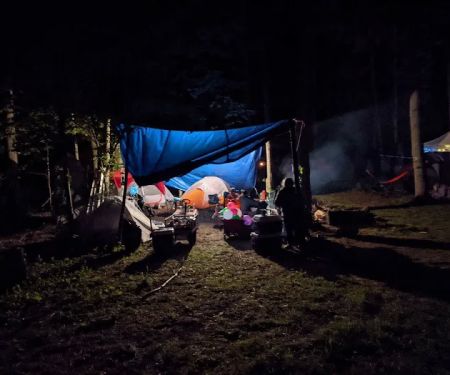 Tent City at Trail Days
4.0 (31 reviews)
Tent City at Trail Days
4.0 (31 reviews)
1011 S Shady Ave, Damascus, VA 24236, USA
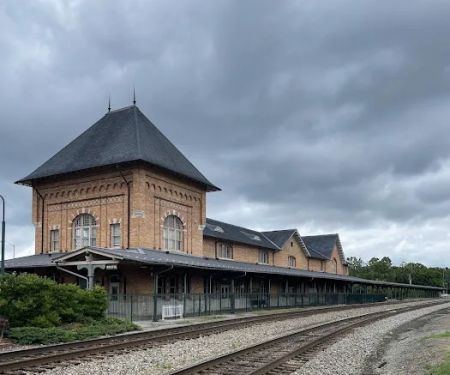 Wolf Lair Campground
4.0 (21 reviews)
Wolf Lair Campground
4.0 (21 reviews)
19091 County Park Rd, Abingdon, VA 24211, USA
Appalachian National Scenic Trail, Shady Valley, TN 37688, USA
 Evergreen Village4.0 (89 reviews)
Evergreen Village4.0 (89 reviews) Chapel Landing Campground4.0 (28 reviews)
Chapel Landing Campground4.0 (28 reviews) East Bay4.0 (24 reviews)
East Bay4.0 (24 reviews) Camp Conley LLC4.0 (75 reviews)
Camp Conley LLC4.0 (75 reviews) Briers Ranch Primitive Camping5.0 (1 reviews)
Briers Ranch Primitive Camping5.0 (1 reviews) Brush Creek Campground3.0 (10 reviews)
Brush Creek Campground3.0 (10 reviews) Exclusive Travel Packages for First-Class Travelers: A Guide to Luxury Vacations
Exclusive Travel Packages for First-Class Travelers: A Guide to Luxury Vacations Refined Travel Experiences in Southeast Asia: Explore Luxury & Unique Destinations
Refined Travel Experiences in Southeast Asia: Explore Luxury & Unique Destinations How to Make the Most of Luxury Vacation Deals: Expert Tips for Savvy Travelers
How to Make the Most of Luxury Vacation Deals: Expert Tips for Savvy Travelers How to Enjoy a Refined Travel Experience in the Mountains
How to Enjoy a Refined Travel Experience in the Mountains Refined Travel Itineraries for Art and Culture Lovers: Explore the World of Art and History
Refined Travel Itineraries for Art and Culture Lovers: Explore the World of Art and History Most Luxurious Destinations for Honeymooners: Top Spots for Romance and Luxury
Most Luxurious Destinations for Honeymooners: Top Spots for Romance and Luxury